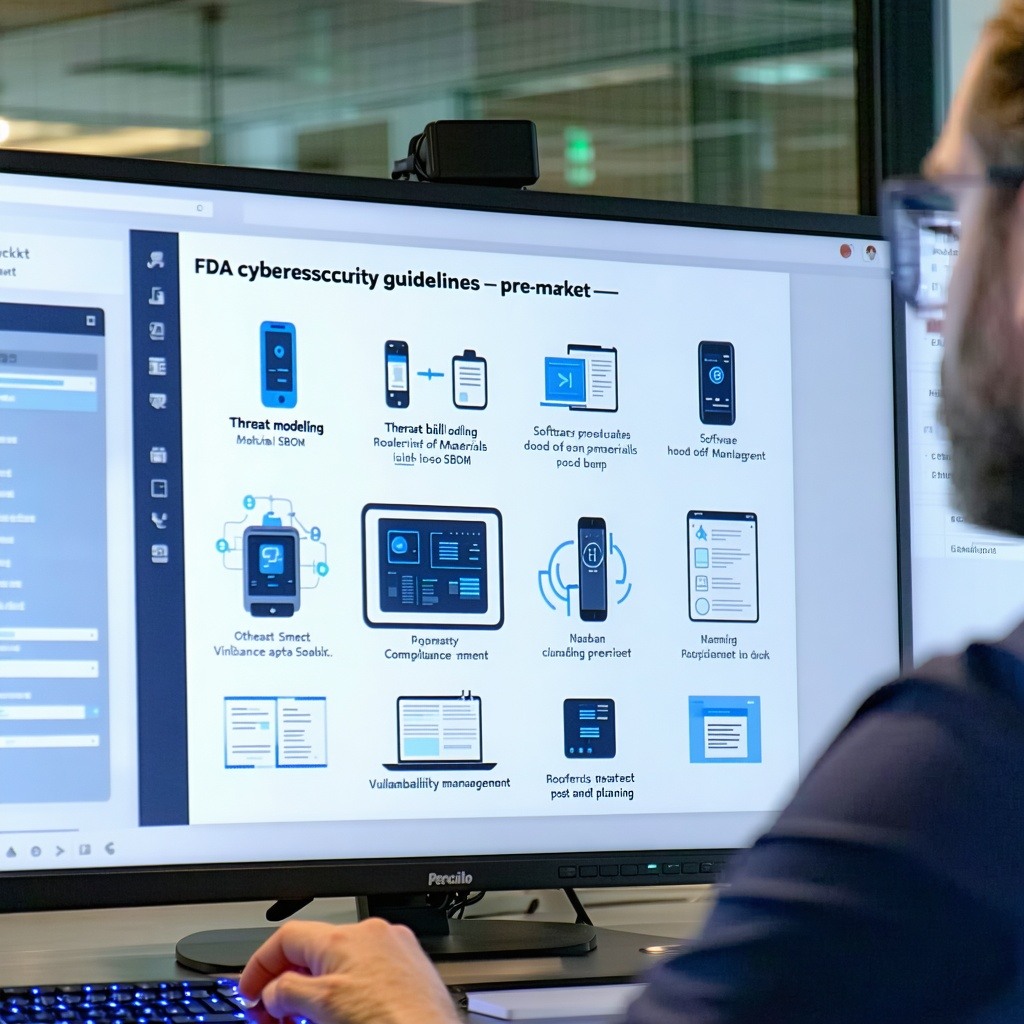Decoding the FDA's Pre-Market Cybersecurity Requirements: A Step-by-Step Guide
Medical device and digital health companies must navigate a complex web of cybersecurity requirements when seeking FDA approval. As healthcare products become more interconnected, regulators have intensified their scrutiny of cybersecurity measures—and for good reason. A single vulnerability could jeopardise patient safety, privacy, and clinical functionality.
At Periculo, we have successfully guided numerous medical device companies through the FDA submission process. We have distilled our expertise into this comprehensive guide to help you confidently meet pre-market cybersecurity requirements.
The Evolving Landscape of FDA Cybersecurity Requirements
The FDA’s approach to cybersecurity has evolved significantly in recent years. In 2023, the agency published its final guidance, Cybersecurity in Medical Devices: Quality System Considerations and Content of Premarket Submissions, setting forth more rigorous expectations for manufacturers.
Today’s submissions require more comprehensive documentation, threat modelling, and security controls than ever before. Below, we outline the essential steps for compliance.
Step 1: Conduct a Thorough Threat Modelling Assessment
What the FDA Requires:
The FDA expects manufacturers to systematically identify threats, vulnerabilities, and risks to their devices.
Actionable Steps:
- Identify Assets – Document all components, interfaces, and data flows within your device.
- Map Threats – Enumerate potential threats to each identified asset.
- Assess Vulnerabilities – Evaluate weaknesses that could be exploited.
- Calculate Risk – Determine the likelihood and severity of each threat scenario.
Documentation Example:
Asset: Bluetooth communication module
Threat: Man-in-the-middle attack intercepting patient data
Vulnerability: Lack of encryption for transmitted data
Risk Level: High (Severity: High, Likelihood: Medium)
Mitigation: Implement AES-256 encryption for all data transmission
Pro Tip: The STRIDE model (Spoofing, Tampering, Repudiation, Information Disclosure, Denial of Service, Elevation of Privilege) is a structured approach that aligns well with FDA expectations.
Step 2: Implement a Secure Development Framework
What the FDA Requires:
Manufacturers must demonstrate that security considerations were integrated throughout the development lifecycle.
Actionable Steps:
- Document Your SDLC – Define your secure development lifecycle methodology.
- Establish Security Requirements – Set security benchmarks at the beginning of development.
- Track Implementation – Provide documentation on how each requirement was implemented and verified.
- Conduct Code Reviews – Ensure security-focused code reviews are part of your process.
Documentation Example:
Security Requirement SR-042: The device must authenticate users before granting access to protected health information (PHI).
Implementation: Multi-factor authentication (biometric and password components).
Verification Method: Penetration testing (Report #PT-2024-113).
Result: Passed—unable to access PHI without valid authentication.
Pro Tip: Referencing established frameworks such as Microsoft SDL or OWASP SAMM demonstrates maturity in your security development process.
Step 3: Develop a Comprehensive Cybersecurity Risk Management Plan
What the FDA Requires:
Manufacturers must have a documented process for ongoing cybersecurity risk management.
Actionable Steps:
- Create a Risk Management Plan – Outline your approach to managing cybersecurity risks.
- Define Risk Assessment Methodology – Specify how risks will be identified, analysed, and evaluated.
- Document Security Controls – Detail how identified risks will be mitigated.
- Plan for Continuous Monitoring – Establish methods for detecting new threats post-market.
Documentation Example:
Risk Management Process: Risk assessment conducted at design milestones using CVSS scoring.
Risk Acceptance Criteria: CVSS scores above 7.0 require mitigation before submission.
Verification Approach: Independent penetration testing by a qualified third party.
Post-Market Monitoring: Subscription to US-CERT, ICS-CERT, and CVE monitoring services.
Pro Tip: Align your risk management strategy with ISO 14971 to ensure integration with overall product risk management.
Step 4: Implement and Document Security Controls
What the FDA Requires:
Manufacturers must provide evidence of security controls addressing identified risks.
Actionable Steps:
- Map Controls to Risks – Clearly document how security measures mitigate specific risks.
- Apply Defence-in-Depth Strategies – Implement multiple layers of security.
- Test Effectiveness – Validate that each control functions as intended.
- Document Secure Configurations – Maintain detailed configuration settings for all components.
Examples of Security Controls:
Authentication Controls
- Control: Enforce minimum password complexity (12 characters, mixed case, numbers, symbols).
- Risk Addressed: Weak credentials leading to unauthorised access.
- Testing Method: Automated testing to block non-compliant passwords.
- Evidence: Test report #TR-AUTH-2024-017.
Encryption Controls
- Control: Data-at-rest encryption using a FIPS 140-2 validated cryptographic module.
- Risk Addressed: Physical theft leading to unauthorised access.
- Testing Method: Attempted data extraction from the device’s storage.
- Evidence: Cryptographic validation report #CVR-2024-003.
Pro Tip: Organise your documentation using the NIST Cybersecurity Framework for a structured and FDA-aligned submission.
Step 5: Develop a Software Bill of Materials (SBOM)
What the FDA Requires:
A complete inventory of software components, including third-party and open-source elements.
Actionable Steps:
- List All Components – Document software elements, their versions, and suppliers.
- Assess Component Risk – Identify security risks associated with each component.
- Track Vulnerabilities – Maintain an updated record of known vulnerabilities.
- Define Update Procedures – Establish a patch management strategy.
Pro Tip: Use SPDX or CycloneDX formats to ensure industry-standard compliance.
Step 6: Prepare a Cybersecurity Risk Management Report
What the FDA Requires:
A comprehensive report summarising cybersecurity measures and findings.
Actionable Steps:
- Summarise Your Approach – Provide an overview of your cybersecurity strategy.
- List Key Risks – Highlight significant risks and mitigation strategies.
- Reference Supporting Documentation – Link risk assessments, test results, and implemented controls.
- Address Residual Risks – Justify any accepted risks.
Pro Tip: Present your cybersecurity measures as a coherent narrative to help reviewers understand your security-by-design approach.
Step 7: Develop a Post-Market Cybersecurity Plan
What the FDA Requires:
A structured approach to managing cybersecurity risks after product launch.
Actionable Steps:
- Monitor for New Vulnerabilities – Establish an ongoing threat detection system.
- Develop Response Procedures – Define how discovered vulnerabilities will be addressed.
- Plan for Customer Communication – Outline how security updates will be relayed.
- Document Patch Management – Ensure timely updates for security threats.
Pro Tip: A robust post-market cybersecurity plan can significantly streamline the FDA review process.
Build a Compliance-Ready Submission
Navigating the FDA’s cybersecurity requirements demands a methodical, well-documented approach. By following this step-by-step guide, you can develop a submission that not only meets regulatory expectations but also enhances your product’s overall security.
At Periculo, we specialise in guiding medical device companies through complex cybersecurity requirements. If you need expert support in preparing your FDA submission, contact our team for a complimentary initial consultation.
%20(1)%20(1).png?width=309&height=69&name=image-001%20(2)%20(1)%20(1).png)


